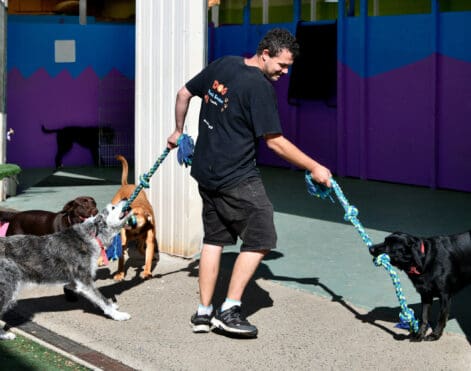Fear periods in dogs

What are Fear Periods in Dogs?
Puppy fear periods or fear stages are normal milestones in puppy development, and all puppies go through them. During these times, puppies are extremely sensitive to traumatic experiences, and scary incidents that occur during these stages will imprint deeply into a young dog’s mind, affecting behaviour for the rest of their life. Therefore, it is important for puppy owners to anticipate the onset of a fear period and avoid any negative or alarming events during a puppy fear stage.
There are two major fear periods in a puppy’s socialization. One is at 8-11 weeks and the other is 6-14 months. These fear periods are evolutionarily programmed and are protective for dogs in the wild. Even though dogs live as pets now, these genetically determined behavioural patterns are still present.
between 2-3 weeks
But if you have a dog going through their first year of life, the most common ages where we see the signs of a fear period are between 8-11 weeks of age, and between 6-14 months of age. Both periods can be expected to last between 2-3 weeks.

Do dogs go through a second fear stage?
The next period in puppy development that often catches owners by surprise is the SECOND FEAR PERIOD, starting anywhere from 6 months to a 1.5 years of age. This second fear period starts as hormones start to kick in during our puppy’s growth to become an adolescent.
All dogs are different and some dogs can have multiple fear stages throughout their lives. Some breeds can have more than others, these breeds usually are more anxious than others.
It’s best to try to create as many positive experiences for your puppy as possible during this time. Make sure to give treats and positive reinforcement for good behavior because it might be difficult for them to determine right from wrong during this period.
WHAT ARE THE MOST COMMON SYMPTOMS OF A FEAR PERIOD?
The signs of fear periods in dogs can vary greatly between dogs, but what they have in common is a sudden onset.
Some of the most common signs include a dog that suddenly:
• Acts afraid of people, animals, and/or unfamiliar objects
• Startles easily at noises or sudden changes (we often see dogs become afraid of their reflection during this time!)
• Barks and backs away from new things. Often we see fearful body language, including pinned ears, tucked tail, and even urination. (Your dog has no control over this type of urination – please don’t punish it!)
• Shows a dramatic behavioural change after a single unpleasant event (for example, your pup is startled by the vacuum cleaner, and will no longer enter the room that the vacuum is in, even when it’s turned off.)

Signs of fear in dogs may include:
• Pacing.
• Panting.
• Shaking/trembling.
• Inability to settle.
• Attempting to hide.
• Lack of appetite (including being unable to take a treat).
• Being too distracted for you to get their attention.
• Salivation.
• Yawning.
• Licking lips.
• Whale eye (showing whites of eyes).
• Lifting a paw.
• Lowered body language.
• Hyperactivity.
• Goofy behaviour (getting the zoomies, scratching etc).
• Loss of toilet training.
• Reactivity.
• Growling.
• Aggression.

SO, HOW DO I HELP MY DOG THROUGH A FEAR PERIOD?
LET’S TALK FIRST ABOUT SURVIVING THE 8-11 WEEK FEAR PERIOD.
How do you help a puppy come through this first period with no long-term effects?
• When first getting your puppy, allow them several days to settle in before you begin any sort of formal training or have any behavioural expectations.
• When possible, transport your new puppy to your home by car. If they must travel by plane, they should fly in the cabin, not in cargo.
• Safely socialize your pup around people and other animals – yes, you do want to start this early!
• Choose a veterinarian and groomer (if needed) that are committed to fear-free care. This means not rushing through the process, allowing puppy time to get comfortable, and minimizing restraint during procedures.
• Don’t force your puppy into interactions that make them uncomfortable. Focus on the quality of the interaction over the quantity.
HOW ABOUT THE 6-14 WEEK FEAR PERIOD?
How do I help my adolescent dog through this challenging time?
• Avoid training methods that risk creating fear or suspicion from your dog. Training to an invisible fence, an e-collar, and/or physical corrections, especially during this sensitive period, has the risk of creating long-term behavioural fallout.
• Focus on working with your dog using positive reinforcement-based methods. Your goal is to continue to strengthen your bond with your dog.
• Avoid on-leash greetings with other dogs. One unpleasant encounter – for example, a dog attacking your dog while on-leash – can set you up for a long road of leash reactivity.
• Do not simply wait for this period to pass. Your dog should still be safely meeting new people and animals (or even just watching them from a distance, if they are extremely uncomfortable with meeting them!), and gaining exposure to new environments. Bring high-value food and toys with you to help create a positive association with those exposures.
• Just like in puppyhood, don’t force interaction. Your dog will come around more quickly if given the chance to explore things at their own pace.

How to Make Things Better
• Use food to make positive associations!
• Have volunteers participate in “mock vet examinations” and use treats
• Practice giving “fake vaccinations” with a pen and use treats
• Make car rides fun!
• Have a DAP diffuser plugged in at home when you bring your puppy home for the first time. Or use lavender oil on collar, bedding or a scarf.
• Make crate-training fun with toys and treats.
General Tips for Dealing With Fear Periods
These tips will come in handy to help you deal with your pampered pooch’s fear periods. However, they also work for dogs who are fearful in general. While they are effective, keep in mind that your dog’s tendency for being fearful may be the work of genetics rather than a temporary problem resulting from a fear stage.
Remain as Calm as Possible
You can lie to your boss, but when it comes to dogs, they are masters at reading our emotions and body language. If you are overly concerned or just a bit tense about your dog acting fearfully or defensively, rest assured your dog will perceive it. Don’t put tension on the leash, get tense, or talk to you in a worried manner. Stay relaxed and loose.
Pretend It’s No Big Deal
Your dog feeds on your emotions. Just as a mother dog would take her pups out from the den and guide the puppies through threatening and non-threatening situations, manifest to your dog that the stimuli he fears are not a big deal.
Counter-Condition
If your dog acts fearfully towards certain stimuli, you can try to change your dog’s emotional response by using treats or anything the dog finds rewarding. The moment your dog sees the threatening stimulus give treats, the moment the threatening stimulus disappears, take the treats away. The same can be done with sounds the dog finds startling, making the sound become a cue that a tasty treat is coming. What if your dog won’t take treats? Most likely, the stimulus is too scary, and the dog is over threshold.

Don’t Overwhelm, Desensitize!
Work, under the threshold from a distance your dog or puppy does not react fearfully and is able to take treats. If you overwhelm and flood your puppy, you risk sensitizing your puppy, which means you make him more fearful. Don’t force your puppy to interact with the feared stimulus; rather allow him to investigate whatever he fears on his own and remember to praise/reward any initiative your puppy or dog takes!
Socialize, Socialize, Socialize
Fear periods are part of a dog’s developmental stages. The more your dog is exposed to stimuli and learns there is nothing to be scared about, the more confident he will be in the future when he will encounter anything intimidating. While the window of opportunity for the puppy socialization phase at around 14 to 16 weeks, socialization opportunities should virtually never end.
Don’t Punish the Fear
Avoid punishing the fear. It appears that the majority of dog aggressive displays are due to fear; therefore, by punishing the behaviour, you will be only exacerbating the fear. Ignore the fear and let your dog build confidence by letting him investigate things on his own when he is ready and praising him for the effort. Use force-free behaviour modification such as desensitization and counterconditioning.
WHAT A FEAR PERIOD ISN’T, AND WHEN TO SEEK HELP:
Remember that if it’s a fear period, you will see a sudden onset of these behaviours in a dog that has been otherwise confident and comfortable.
If you have a dog or puppy that has been experiencing any of these signs for more than 2-3 weeks, you’re seeing a consistent worsening of fearful behaviours, and/or you have acquired a new dog or puppy that came to you already showing these behaviours, seek professional guidance. From vet or dog trainer.






